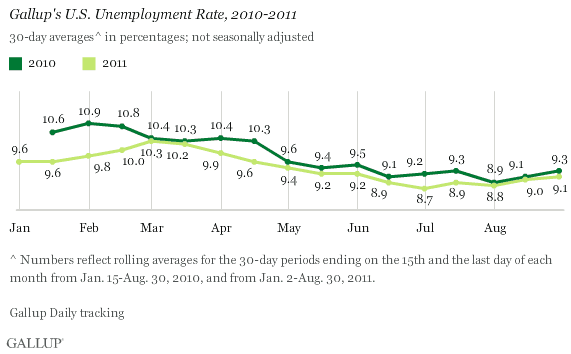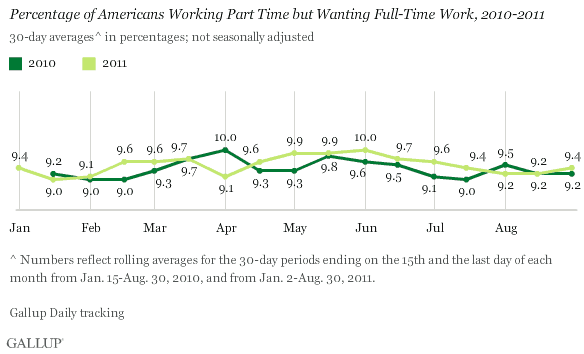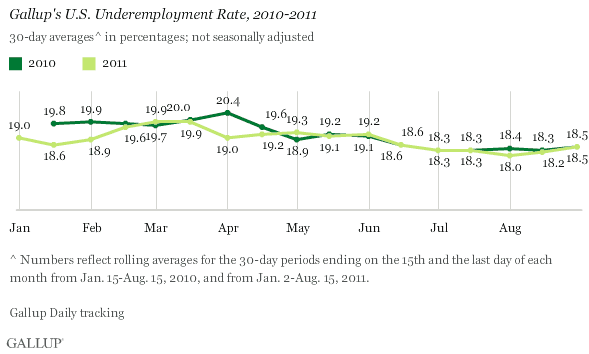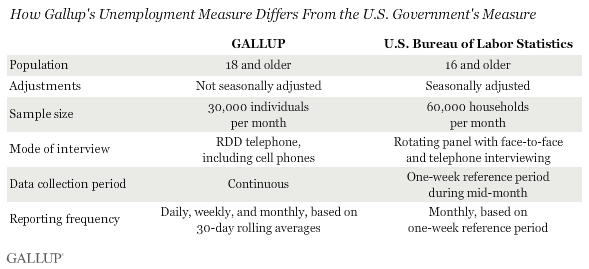PRINCETON, NJ -- Unemployment, as measured by Gallup without seasonal adjustment, is at 9.1% at the end of August -- up from 8.8% at the end of July.

These data further confirm Gallup's mid-month prediction that the August unemployment rate that the government will report Friday will be higher than the 9.1% it reported in July -- barring another sizable decline in the U.S. workforce or an unusual seasonal adjustment.
The percentage of part-time workers who want full-time work is at 9.4% at the end of August -- up from 9.2% in mid-August and at the end of July.

Underemployment Worsens in August
Underemployment, a measure that combines the percentage of workers who are unemployed with the percentage working part time but wanting full-time work, is 18.5% at the end of August -- up from 18.0% at the end of July.

The increase in unemployment and underemployment that Gallup finds in August is reflected by Americans' elevated level of concern about losing their jobs. Thirty percent of U.S. workers in an Aug. 11-14 Gallup poll said they fear being laid off, which essentially matches the record-high 31% who said the same in August 2009. This may also signal additional job losses yet to come.
Looking Ahead to the Government's Next Unemployment Report
The government's August unemployment report will be based on data collected during mid-August, around the time Gallup released its mid-month findings. At that time, Gallup suggested that the government would report an increase in the U.S. unemployment rate for August. The continued job deterioration Gallup has found since mid-month reinforces this idea.
Gallup's end-of-August data are consistent with Wednesday's slightly disappointing report from ADP, the nation's largest payroll service, which found a less-than-predicted rise in private-sector payrolls. These data are also consistent with the possibility that the government will report that the U.S. unemployment rate increased in August, although the consensus expectation is that it will be unchanged.
One caveat is that Gallup's unemployment numbers are not seasonally adjusted, and the way the government adjusts its unemployment report for seasonal effects may affect Friday's report. There is also the issue of the shrinking U.S. workforce. Last month, the number of Americans in the labor force declined by nearly 200,000. The number of Americans in the labor force is down about 400,000 over the past year. If more Americans got discouraged and simply dropped out of the job market in August -- meaning they are no longer counted as unemployed because they are no longer actively seeking work -- the government may end up reporting a lower unemployment rate than Gallup's unemployment data suggest.
While the dismal job situation is a negative for the economic outlook, unemployment is generally seen as a lagging indicator. Americans' worries about potentially being laid off are much more of a leading indicator, and Americans are now worried about losing their jobs to the same degree they were in 2009. People are likely worried about their job situation both because their Economic Confidence is low, and because they fear their companies may be scaling back on hiring. When a large percentage of Americans are worried about their jobs, it does not bode well for consumer spending or the prospects for another recession.

Gallup.com reports results from these indexes in daily, weekly, and monthly averages and in Gallup.com stories. Complete trend data are always available to view and export in the following charts:
Daily: Employment, Economic Confidence and Job Creation, Consumer Spending
Weekly: Employment, Economic Confidence, Job Creation, Consumer Spending
Read more about Gallup's economic measures.
View our economic release schedule.
Survey Methods
Gallup classifies American workers as underemployed if they are either unemployed or working part time but wanting full-time work. The findings reflect more than 18,000 phone interviews with U.S. adults aged 18 and older in the workforce, collected over a 30-day period. Gallup's results are not seasonally adjusted and are ahead of government reports by approximately two weeks.
Results are based on telephone interviews conducted as part of Gallup Daily tracking from Aug. 1-30, 2011, with a random sample of 18,450 adults, aged 18 and older, living in all 50 U.S. states and the District of Columbia, selected using random-digit-dial sampling.
For results based on the total sample of national adults, one can say with 95% confidence that the maximum margin of sampling error is ±1 percentage point.
Interviews are conducted with respondents on landline telephones and cellular phones, with interviews conducted in Spanish for respondents who are primarily Spanish-speaking. Each sample includes a minimum quota of 400 cell phone respondents and 600 landline respondents per 1,000 national adults, with additional minimum quotas among landline respondents by region. Landline telephone numbers are chosen at random among listed telephone numbers. Cell phone numbers are selected using random-digit-dial methods. Landline respondents are chosen at random within each household on the basis of which member had the most recent birthday.
Samples are weighted by gender, age, race, Hispanic ethnicity, education, region, adults in the household, and phone status (cell phone only/landline only/both, cell phone mostly, and having an unlisted landline number). Demographic weighting targets are based on the March 2010 Current Population Survey figures for the aged 18 and older non-institutionalized population living in U.S. telephone households. All reported margins of sampling error include the computed design effects for weighting and sample design.
In addition to sampling error, question wording and practical difficulties in conducting surveys can introduce error or bias into the findings of public opinion polls.
For more details on Gallup's polling methodology, visit www.gallup.com.
